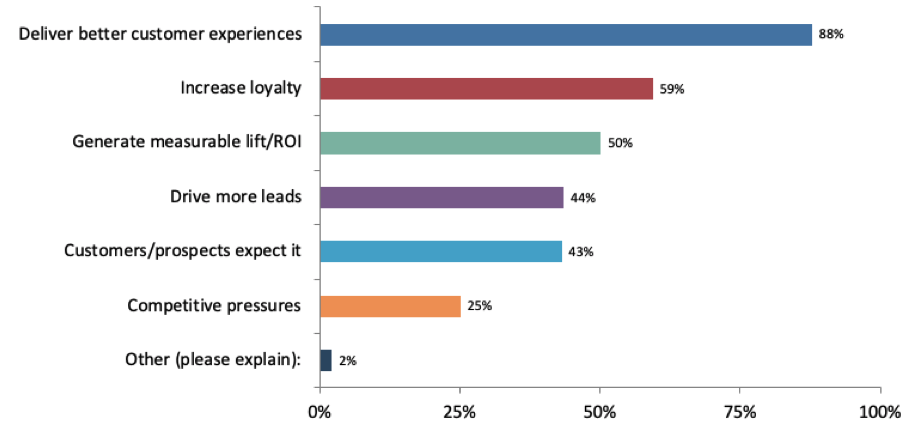
Personalization continues to be an important component of good customer experiences. And with the trend toward customer data platforms (CDPs), which aim to bring customer data together in one place in order to activate on it to deliver more targeted experiences, personalization is clearly a top priority.
Last week, we published our sixth annual study with Researchscape International, entitled 2019 Trends in Personalization. We also hosted a webinar where Andy Zimmerman, Evergage CMO, and I reviewed some of our key findings.
In this blog post, I’ll summarize a few of the points we made. For more detail, check out the webinar replay.
Delivering a better experience is the top reason marketers use personalization
There’s no question that marketers find value in personalization. The vast majority (98%) of marketers believe that personalization has at least some impact on advancing customer relationships, and 70% believe it has a “strong” or “extremely strong” impact. And 85% of marketers believe that their customers expect personalized experiences.
This year, we asked marketers what drives them to provide personalization. We discovered that the main reason is to “deliver better experiences,” followed by “increase loyalty” and “generate measurable lift/ROI.” It appears that marketers prioritize personalization mainly because they feel it’s the right choice for their customers.
What are the drivers of personalization in your organization?
Marketers are becoming more sophisticated in their personalization approach
Email remains the most-personalized channel (78%), followed by web (58%), and in-person (42%). Interestingly, online advertising trails behind at 35%. Given the budget many marketers dedicate to their advertising campaigns, it’s interesting that many are not personalizing their efforts.
That being said, marketers are becoming more sophisticated in their personalization approach. Usage of machine-learning/algorithmic personalization is up from 26% last year to 40% this year. Emails triggered based on a person’s site behavior is up from 35% last year to 45% this year. And campaign source is far and away the most-used criterion for targeting personalized experiences, cited by nearly half (49%) of marketers. When you personalize an experience based on campaign source, you are typically personalizing a website experience based on where the visitor arrived from — like a specific email or advertising campaign. This type of cross-channel consistency is only possible when marketers can connect channels together.
Which of the following criteria do you use for targeting your audience in order to personalize the experience?
Marketers have made progress in this area as well. The percentage of marketers that say they have “no channels connected” declined from 27% to 21% this year, while the percentage of those that say they have “a few channels connected” rose from 46% to 53%.
Marketers continue to invest in and see results from personalization
Marketers continue to see strong, measurable results from their personalization efforts. The majority (90%) see at least some lift, while more than half (58%) see a lift of 10% or more. Of those marketers using machine learning, 77% report a lift of 10% or more.
This ROI is translating into continued investment. The vast majority (97%) are planning to maintain or increase their investment in personalization over the next year, and the percentage of those planning to increase it rose from 37% to 48% this year.
Still, 74% of marketers believe that personalization should be a bigger priority in their businesses. What are the obstacles they’re facing? As in past years, lack of budget, lack of personnel, and lack of knowledge or skills are at the top of the list. Yet each of those has been steadily declining in the last three years. Meanwhile, lack of organizational alignment has been slowing increasing as an obstacle to making personalization a bigger priority.
What are the greatest obstacles to making personalization a bigger priority in your organization?
As marketers work through growing pains and establish processes for personalization, we may see this continue to trend upwards over the next few years.
Wrap Up
We’re excited to see that this year, marketers continue to value personalization and see meaningful results from their efforts — and that they’re becoming more sophisticated in their approach.
To discover more insights from this year’s study, be sure to watch the full webinar replay and read the full report.
Read more: Inventory Planning for Chinese New Year: Time to Get Ready



